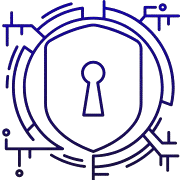Cybersecurity means protecting systems, networks, applications, and data from digital attacks that try to access, change, or destroy sensitive information.
Today, attackers move fast and devices outnumber people, which expands the attack surface for organizations. Simple steps by users—strong passwords, careful email habits, and regular backups—reduce risk immediately.
A layered approach combines people, processes, and technology. That mix uses endpoint defenses, next-generation firewalls, DNS filtering, and email security to stop incidents and limit damage.
The NIST framework helps teams identify assets, protect them, detect suspicious activity, respond to incidents, and recover operations. Integrated tools like XDR, SIEM, and SOAR help prioritize signals and speed response across tools.
This guide shows core domains—network protections, cloud controls, endpoint defenses, application hardening, and data safeguards—so beginners can map practical solutions to their environment. The goal is not zero attacks but to lower likelihood and impact through smart controls, planning, and continuous improvement.
Key Takeaways
- Security protects systems, network infrastructure, applications, and data from malicious access and attacks.
- A layered defense ties people, processes, and tools into practical solutions.
- Follow basic user practices to cut immediate risk.
- Use frameworks like NIST to structure efforts across identify, protect, detect, respond, recover.
- Integrated tools (XDR, SIEM, SOAR) speed detection and coordinated response.
- Focus on reducing impact and improving over time rather than seeking perfect prevention.
Cybersecurity in 2025: What It Is and Why It’s Different Now
A solid security posture in 2025 ties identity, device health, and network context to every access decision. Coverage must span on-prem systems, cloud workloads, applications, and data so nothing falls outside protection.
Why 2025 feels different: distributed work, cloud-native apps, and many more connected devices increase complexity. Those changes create more paths a cyber threat can use if controls are inconsistent.
People, processes, and technology must work together. Train staff on phishing, map playbooks to the NIST lifecycle, and deploy integrated solutions that correlate events across endpoints and networks for faster response.
Beginner goals are measurable: reduce risk in critical workflows, encrypt and classify sensitive data, and test backups and recovery plans to preserve business continuity.
Governance and asset inventories tell organizations what they own and who can access it. Central visibility helps teams prioritize high-impact vulnerabilities before smaller issues snowball.
- Start with quick wins: patching, MFA, and backups.
- Then harden cloud configs and adopt secure-by-design development.
- Use identity and device posture to avoid over‑permissive access.
Why Cybersecurity Matters Today
Weekly counts of digital intrusions climbed sharply in 2024, forcing leaders to treat online risk as a board-level issue.
Rising attack volume and business impact in the United States
The average number of weekly attacks on organizations reached 1,673 in 2024/2025, a 44% year‑over‑year rise. That surge reflects larger digital footprints across cloud apps, third‑party vendors, and remote work.
Expanded environments let threat actors gain access through misconfigurations, weak credentials, and unpatched services. Both state‑backed groups and low‑skill affiliates using Malware‑as‑a‑Service drive this scale.
Reputation, regulatory, and operational consequences of data breaches
Incidents cause operational downtime, remediation costs, regulatory fines, and long‑term brand damage that can outlast the technical fix. Sectors like healthcare and finance face higher stakes due to sensitive information and uptime needs.
Security is a business function: proper controls, tabletop exercises, and tested recovery plans cut risk and shrink downtime. Insurers now demand MFA, EDR/XDR, backups, and segmentation before offering favorable terms.
- Timely response and clear communication help contain losses and meet compliance timelines.
- Executive oversight with measurable metrics ties investment to real business risk.
Cybersecurity Basics: Definitions, Goals, and Core Principles
Good security starts with a clear set of goals and simple controls you can test quickly. These basics guide daily choices and help teams focus on the highest risks.
The CIA triad: confidentiality, integrity, availability
Confidentiality—protect sensitive information with encryption and strict access controls.
Integrity—use checksums, versioning, and audit logs so data and applications stay trustworthy.
Availability—plan redundancy, backups, and failover so systems stay online when needed.
NIST framework: identify, protect, detect, respond, recover
Map the framework to daily work: asset inventories and risk assessments, controls like MFA and segmentation, continuous monitoring, playbooks for response, and tested recovery procedures.
Foundational best practices
Patch operating systems and applications promptly. Enforce strong, unique passwords and use password managers. Require MFA—ideally phishing-resistant methods such as FIDO2—for privileged and remote access.
“Adopt these fundamentals first; they form the base for advanced models like zero trust and SASE.”
- Segment networks and apply least privilege to limit lateral movement.
- Run vulnerability cycles: scan, prioritize, remediate.
- Test backups and document response runbooks with tabletop exercises.
Types of Cybersecurity: The Pillars You Should Know
Understanding core security domains makes it easier to defend data, devices, and cloud workloads. Below are the main pillars that organizations use to map risks to practical controls and tools.
Network defenses
Network security relies on next‑generation firewalls, IPS, DNS filtering, and traffic inspection. These controls enforce policies and block suspicious behavior before an attack reaches internal systems.
Information and data protections
Data security starts with classification. Add DLP to discover and prevent unauthorized sharing, and encrypt data at rest and in transit to reduce interception and misuse.
Cloud and hybrid controls
Cloud security extends IAM, MFA, policy checks, and posture assessment across public and private clouds. Align controls to provider shared‑responsibility models for workloads and configurations.
Endpoint and device defenses
Endpoint security combines antivirus, EDR, and mobile device management so desktops, laptops, and phones can be detected and contained when malware or compromise appears.
Application hardening
Protect applications with secure SDLC practices, secret management, and WAFs to block injections and XSS. Use the OWASP Top 10 as a checklist to reduce vulnerabilities before deployment.
Zero trust principles
Zero trust assumes no implicit access. Require continuous verification, device posture checks, ZTNA, and microsegmentation to limit lateral movement and improve protection.
“Combine these pillars—for example, DLP with email filtering or ZTNA with EDR—to reduce blind spots and speed remediation.”
OT, IoT, and Cyber‑Physical Systems Security
Industrial control systems now face the same internet-born risks as office IT, widening exposure for critical infrastructure. OT systems run power, transport, and manufacturing processes that historically sat isolated. As IT and OT converge, attackers can reach safety-critical functions through corporate networks.
Convergence of IT and OT: new risks to critical infrastructure
Mixing IT and OT increases the attack surface and likelihood of cascading failures. Threats that used to affect only desktops can now interrupt production lines or grid controls.
IoT device discovery, segmentation, and authentication
Many iot devices and OT controllers lack frequent firmware updates. That makes them hard to patch and monitor.
- Use continuous discovery and classification to inventory devices and rank risk.
- Apply network segmentation and microsegmentation to isolate systems and limit the blast radius.
- Require strong authentication and encrypted protocols for device-to-system access.
- Deploy IPS as a virtual patch to block known vulnerabilities when firmware updates are impractical.
Combine passive network telemetry with targeted sensors to monitor without disrupting equipment. Also align engineering, safety, and security teams for coordinated change control and emergency response.
“Protecting the data from sensors and controllers preserves the integrity of analytics and safety decisions.”
Security Architecture and Strategy for Modern Organizations
Effective defense begins with who needs access, what they can reach, and how trust is revalidated over time. Build a security strategy that assumes breach and designs least-privilege access from day one.
Zero trust is a strategy, not a product. It combines MFA, device posture checks, ZTNA, and segmentation to reduce the chance an attacker can gain access to high-value information.

Zero Trust Network Access, device posture, and segmentation
ZTNA brokers access based on identity, device health, and context. It limits what users and devices can reach and revalidates trust during sessions.
Layer segmentation at network and application levels to block lateral movement. Protect critical servers and data by isolating them behind strict policy fences.
SASE for secure access at the edge
SASE converges networking and security in the cloud so remote users and branches get consistent policy and better performance.
This model simplifies policy management across multi-cloud and hybrid environments and helps enforce consistent controls for distributed sites.
Identity and access management: authentication, authorization, monitoring
A modern IAM program uses strong authentication, granular authorization, and continuous monitoring to enforce least privilege.
Evaluate endpoint health before granting access and re-check it at policy intervals. Use risk-based access that adjusts controls by behavior, location, and resource sensitivity.
- Centralize policy and automate configuration to keep solutions consistent.
- Sequence roadmap milestones: identity, ZTNA, segmentation for quick wins.
- Measure outcomes: policy coverage, mean time to detect and respond, and regular access reviews.
Design for measurable risk reduction—align controls to business outcomes, track coverage, and prove the strategy works over time.
Threats and Attacks Shaping 2025
Adversaries now use AI to tailor malicious content, making attacks more frequent and harder to spot. This trend forces teams to treat threats as fast-moving, adaptive campaigns rather than isolated incidents.
AI‑powered phishing, malware, and deepfakes
AI supercharges social engineering. Phishing messages and deepfake audio or video look authentic, tricking trained staff and automated filters alike.
Defenders must pair advanced email filtering with behavior analytics to catch subtle indicators of compromise.
Ransomware‑as‑a‑Service and extortion
RaaS expands reach: affiliates launch campaigns using professional malware. Ransomware now layers data theft, public shaming, and DDoS in double or triple extortion to pressure organizations to pay.
Zero‑day exploits, supply chain, and Gen V attacks
Zero-day vulnerabilities and supply chain compromises let attackers bypass perimeters and hit many targets at once.
Gen V, multi‑vector attacks combine email, web, endpoint, and cloud techniques to overwhelm siloed defenses.
- Apply hybrid mesh firewall platforms to centralize policy across on‑prem, cloud, and edge.
- Maintain continuous monitoring for anomalous identity and iot devices traffic.
- Run tabletop exercises for destructive malware and supplier compromise scenarios.
“Invest in prevention, rapid endpoint containment, identity protection, and advanced email filtering to shrink the blast radius of modern campaigns.”
Data Security and Access Management
Start by mapping the flow of critical information across devices, apps, and suppliers. A clear inventory shows where sensitive data sits and how it moves so teams can set priorities for protection.
Protecting sensitive data with DLP and encryption
Use DLP tools to discover and classify data as it’s created. DLP monitors endpoints, email, cloud apps, and the network to block risky transfers in real time.
Encrypt data at rest and in transit, manage keys securely, and apply tokenization or field‑level encryption for regulated information.
Access management and zero trust controls to limit lateral movement
Access controls must authenticate strongly, grant minimum permissions, and log activity continuously. Just‑in‑time elevation and session recording reduce insider misuse.
- Define outcomes: where data lives, who can reach it, and how to enforce policies.
- Detect violations and automate remediation—quarantine files or revoke access fast.
- Keep audit‑ready logs to speed investigations after data breaches.
“Least privilege plus segmentation shrinks what a compromised account can touch.”
Detection, Response, and Prevention Technology Stack
Visibility across endpoints, networks, and cloud apps lets teams stop threats before they spread. Build a stack that detects fast, automates containment, and prevents recurrence.

Endpoint detection and response (EDR) and extended detection and response (XDR)
EDR gives continuous visibility on each endpoint. It detects suspicious behavior and can isolate compromised devices to prevent lateral movement.
XDR correlates telemetry from endpoint, network, identity, email, and cloud. That integration raises detection quality and shortens coordinated response times.
SIEM and SOAR: centralized visibility and automated workflows
SIEM centralizes logs and events from systems and applications so analytics can surface hidden threat patterns at scale.
SOAR automates enrichment, triage, and playbook-driven containment. It shrinks mean time to respond during high-volume investigations.
NGFW and IPS: deep inspection and real‑time blocking
Next‑generation firewalls provide application awareness and deep packet inspection. Paired with IPS, they block known malware and suspicious exploitation attempts at the network edge and internal segments.
CNAPP for cloud‑native application protection
CNAPP unifies posture management, workload runtime defense, and CI/CD checks. It reduces misconfigurations and keeps cloud applications and data safer.
“Integrate tools end-to-end: SIEM alerts can trigger SOAR runbooks that instruct EDR/XDR to quarantine endpoints or NGFW/IPS to block indicators.”
| Component | Primary Role | Key Benefit |
|---|---|---|
| EDR | Endpoint monitoring & isolation | Stops spread from compromised devices |
| XDR | Cross-layer correlation | Improves detection quality and prioritization |
| SIEM + SOAR | Log analytics & automation | Speeds incident response and reduces manual work |
| NGFW / IPS | Traffic inspection & blocking | Real-time defense against malware and exploits |
| CNAPP | Cloud-native app protection | Prevents misconfiguration and runtime risk |
- Map use cases to business risk and run regular threat hunting to cut alert fatigue.
- Build incident response playbooks with decision trees, communications, legal steps, and restoration priorities.
- Track consistent metrics—time to detect, time to respond, and dwell time—to guide investment in cybersecurity solutions.
Securing Remote Work, Cloud, and Mobile Devices
Remote and hybrid setups change how trust is granted: devices and networks outside the office need continuous verification. This requires identity controls, endpoint checks, and secure network paths before granting access.
Remote and hybrid work: securing endpoints and identities
Require MFA everywhere and use device posture checks to reduce risk from unmanaged endpoints. Apply endpoint security agents that enforce minimum baselines before access is allowed.
Protect home and public networks with vetted VPN or ZTNA clients and DNS filtering to block malicious sites and malware. Train remote staff to spot social engineering and suspicious consent prompts.
Cloud security posture and safe, frictionless access
Use cloud security posture management and least‑privilege roles to avoid broad permissions in SaaS and IaaS. Regularly review API keys, entitlements, and application access to remove stale rights.
Context-aware access—risk-based checks for location, device health, and session behavior—balances protection and productivity. SASE or ZTNA models centralize policy while keeping performance high.
Mobile OS hardening, MDM, and phishing defenses on the go
Manage smartphones and tablets with MDM: enforce OS updates, app whitelists, containerization, encryption at rest, and remote wipe for lost devices. Harden operating systems by disabling unused services and restricting permissions.
Combine technical controls with focused training so users recognize mobile phishing and report suspicious links. Layered solutions—MDM, DLP, network controls—improve resilience when attacks target remote users and unmanaged networks.
Practical rule: enforce MFA, posture checks, and least‑privilege access; review entitlements regularly to keep remote access safe.
People, Skills, and Services That Strengthen Cybersecurity
People are the first line of defense; training turns everyday users into dependable detectors of scams. Ongoing awareness programs teach staff to spot phishing, malware, and social engineering. Realistic simulations and role-based lessons help teams practice safe responses.
Security awareness training to counter social engineering
Training reduces human risk by turning mistakes into learning moments. Use measured campaigns, simulated phishing, and clear reporting steps so users escalate suspicious activity fast.
Cybersecurity certifications to close the skills gap
Most organizations prefer certified candidates (91%), will fund training (90%), and report improved performance from certified teams (95%). Prioritize certifications for both practitioners and leaders to raise operational maturity.
Managed security services, MDR, and XDR to extend your team
MSSPs offer managed firewalls, vulnerability management, and 24/7 monitoring with flexible pricing. MDR focuses on endpoint-centric detection and SOC analyst response. XDR correlates signals across endpoint, network, email, and cloud for broader detection and faster response.
“Build people, processes, and trusted services together so tools deliver real protection under pressure.”
| Service | Primary Role | Key Benefit |
|---|---|---|
| Security Awareness | User training & phishing simulation | Reduces successful social engineering attempts |
| Certifications | Skills validation | Improves team performance and hiring success |
| MSSP / Managed Services | 24/7 monitoring & operations | Scales protection without hiring fully in-house |
| MDR | Endpoint detection & SOC response | Rapid containment of compromised systems |
| XDR | Cross-layer correlation | Faster detection and coordinated response |
- Govern training cadence, content, and success metrics to measure risk reduction.
- Vet providers for SLAs, data handling, and integration with existing systems.
- Encourage knowledge sharing so service partners upskill internal teams over time.
Conclusion
Rising attack sophistication in 2025 forces organizations to treat protection as an ongoing program, not a one‑time project.
Make risk reduction, resilience, and business continuity the priorities for any security effort. Use NIST‑style processes, least privilege, segmentation, and tested recovery as the durable foundation across cloud and on‑prem environments.
Adopt a security strategy that ties identity, device posture, and centralized policy together. Modern solutions—hybrid mesh firewalls, CNAPP, SASE, and IAM—help secure distributed networks and devices while improving visibility.
Deploy EDR/XDR, SIEM/SOAR, NGFW/IPS, and data controls (DLP and encryption) to close detection gaps and shorten response when a cyber threat or attack appears.
Invest in people: training, certifications, playbooks, and regular reviews of access, configurations, and third‑party dependencies. Start with achievable steps—MFA, patching, and backups—then plan phased rollouts of zero trust and segmentation.
Assess your posture, prioritize high‑impact fixes, and commit to continuous improvement to protect customers, employees, and brand. strong.
FAQ
What is cybersecurity and what does it cover in 2025?
Cybersecurity is the practice of protecting systems, networks, applications, and data from unauthorized access, damage, or disruption. In 2025 it spans traditional IT, cloud and hybrid environments, operational technology (OT), and Internet of Things (IoT) devices. It combines people, processes, and technology—like identity and access management, endpoint security, network controls, and data protection—to reduce risk and keep businesses running.
Why does cybersecurity matter now more than before?
Attack volume and sophistication are rising, increasing financial, operational, and reputational harm for U.S. organizations. Regulatory fines and customer trust losses follow breaches. Protecting sensitive data and maintaining business continuity are central to avoiding costly disruptions and legal consequences.
What are the core principles organizations should follow?
Start with the CIA triad—confidentiality, integrity, and availability. Use the NIST framework steps: identify, protect, detect, respond, and recover. Adopt foundational best practices such as timely patching, strong password policies, and multi-factor authentication to lower basic risk.
What types of security should my organization invest in?
Build a layered program: network security (firewalls, IPS), information and data protection (classification, DLP, encryption), cloud security (controls and visibility for multi/hybrid cloud), endpoint security (EDR, antivirus, mobile device management), application security (WAF, secure SDLC), and a zero trust model enforcing least privilege and continuous verification.
How do IoT and OT devices change the risk profile?
Convergence of IT and OT exposes critical infrastructure to cyber threats. IoT devices often lack strong security by design, so discovery, segmentation, device authentication, and continuous monitoring are essential to limit attack surface and reduce the chance of lateral movement into sensitive systems.
What architecture and strategies work best for modern organizations?
Zero Trust Network Access with device posture checks, microsegmentation, and strong identity controls reduces implicit trust. SASE consolidates networking and security at the edge for remote users. Centralized identity and access management with continuous monitoring helps enforce policies across platforms.
What threat trends are shaping 2025?
Expect AI‑assisted phishing and deepfake scams, ransomware-as-a-service with double or triple extortion, supply chain compromises and zero-day exploits, and complex multi-vector attacks targeting cloud and hybrid environments. Rapid detection and layered defenses are critical.
How should organizations protect sensitive data and manage access?
Classify data, apply encryption in transit and at rest, and use data loss prevention tools to limit exfiltration. Combine role-based and attribute-based access controls with zero trust policies to minimize lateral movement and ensure least-privilege access.
Which tools form an effective detection and response stack?
Deploy endpoint detection and response (EDR/XDR) for host telemetry, SIEM and SOAR for centralized visibility and automation, next-generation firewalls and IPS for network inspection, and CNAPP to secure cloud-native applications. Integration and playbooks speed incident handling.
How can organizations secure remote work, cloud services, and mobile devices?
Protect remote and hybrid workers with strong identity controls, device posture checks, MDM or unified endpoint management, and encrypted communications. Maintain cloud security posture management and least-privilege access to reduce exposure across SaaS and IaaS platforms.
What role do people and services play in strengthening security?
Training to counter social engineering lowers human risk. Certifications help close skill gaps. Managed services—MDR and XDR—extend internal teams, providing continuous monitoring, threat hunting, and faster response for organizations lacking full in-house capabilities.
How do I prioritize investments with limited budget and staff?
Focus on high-impact controls: identity and access management with MFA, endpoint detection, timely patching, and network segmentation. Use risk-based assessments to protect critical assets first, and consider managed detection and response to get expert coverage without hiring a large team.

